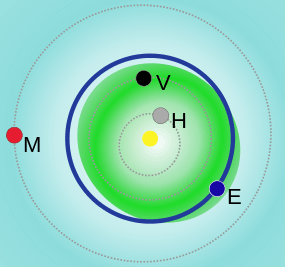(153201) 2000 WO107
| Discovery[1] | |
|---|---|
| Discovered by | LINEAR |
| Discovery site | Socorro, New Mexico, USA |
| Discovery date | 29 November 2000 |
| Designations | |
| MPC designation | 2000 WO107 |
| MPO 330062, MPO169985 | |
Aten  NEO, PHA | |
| Orbital characteristics[2] | |
| Epoch 13 January 2016 (JD 2457400.5) | |
| Uncertainty parameter 0 | |
| Observation arc | 5566 days (15.24 yr) |
| Aphelion | 1.622813052 AU (242.7693771 Gm) |
| Perihelion | 0.199925711 AU (29.9084607 Gm) |
| 0.911369382 AU (136.3389190 Gm) | |
| Eccentricity | 0.78063152 |
| 0.87 yr (317.8 d) | |
| 194.207724° | |
| 1.1328240°/day | |
| Inclination | 7.7714772° |
| 69.268373° | |
| 213.698455° | |
| Earth MOID | 0.0030372 AU (454,360 km) |
| Jupiter MOID | 3.55067 AU (531.173 Gm) |
| Physical characteristics | |
| Dimensions | 375–845 m[3] |
| X[4] | |
| 19.3[2] | |
|
| |
(153201) 2000 WO107 is a small asteroid that is a Near-Earth object and an Aten asteroid.
Orbit
The orbit of (153201) 2000 WO107 has been well-established with over 14 years of observations. The orbit of (153201) 2000 WO107 makes it a potentially hazardous asteroid (PHA)[5] that is predicted to pass within 0.001629 AU (243,700 km) of the Earth in the year 2140.[2] For comparison, the distance to the Moon is about 0.0026 AU (384,400 km). However, the asteroid does not appear on the list of PHA close approaches issued by the Minor Planet Center (MPC).[6]
The Jupiter Tisserand invariant, used to distinguish different kinds of orbits, is 6.228.[2]
Physical characteristics
The SMASSII spectral type is X.[4]
See also
References
- ↑ "(153201) = 2000 WO107". Minor Planet Center. 2015-01-25.
- 1 2 3 4 "JPL Small-Body Database Browser: 153201 (2000 WO107)" (last observation: 2015-01-25; arc: 5170 days). Jet Propulsion Laboratory. Retrieved 7 April 2016.
- ↑ "ABSOLUTE MAGNITUDE (H)". NASA.
- 1 2 Binzel, Richard P.; Rivkin, Andrew S.; Stuart, J. Scott; Harris, Alan W.; Bus, Schelte J.; Burbine, Thomas H. (20 March 2004). "Observed spectral properties of near-Earth objects: results for population distribution, source regions, and space weathering processes" (PDF). Icarus. Mount Holyoke. 170: 259–294. Bibcode:2004Icar..170..259B. doi:10.1016/j.icarus.2004.04.004.
- ↑ "List Of The Potentially Hazardous Asteroids (PHAs)". Minor Planet Center. Retrieved 2015-05-06.
- ↑ "PHA Close Approaches To The Earth". Minor Planet Center. Retrieved 2015-05-06.
External links
| Preceded by 2007 UW1 |
Large NEO Earth close approach (inside the orbit of the Moon) 1 December 2140 |
Succeeded by (85640) 1998 OX4 |
This article is issued from Wikipedia - version of the 6/29/2016. The text is available under the Creative Commons Attribution/Share Alike but additional terms may apply for the media files.